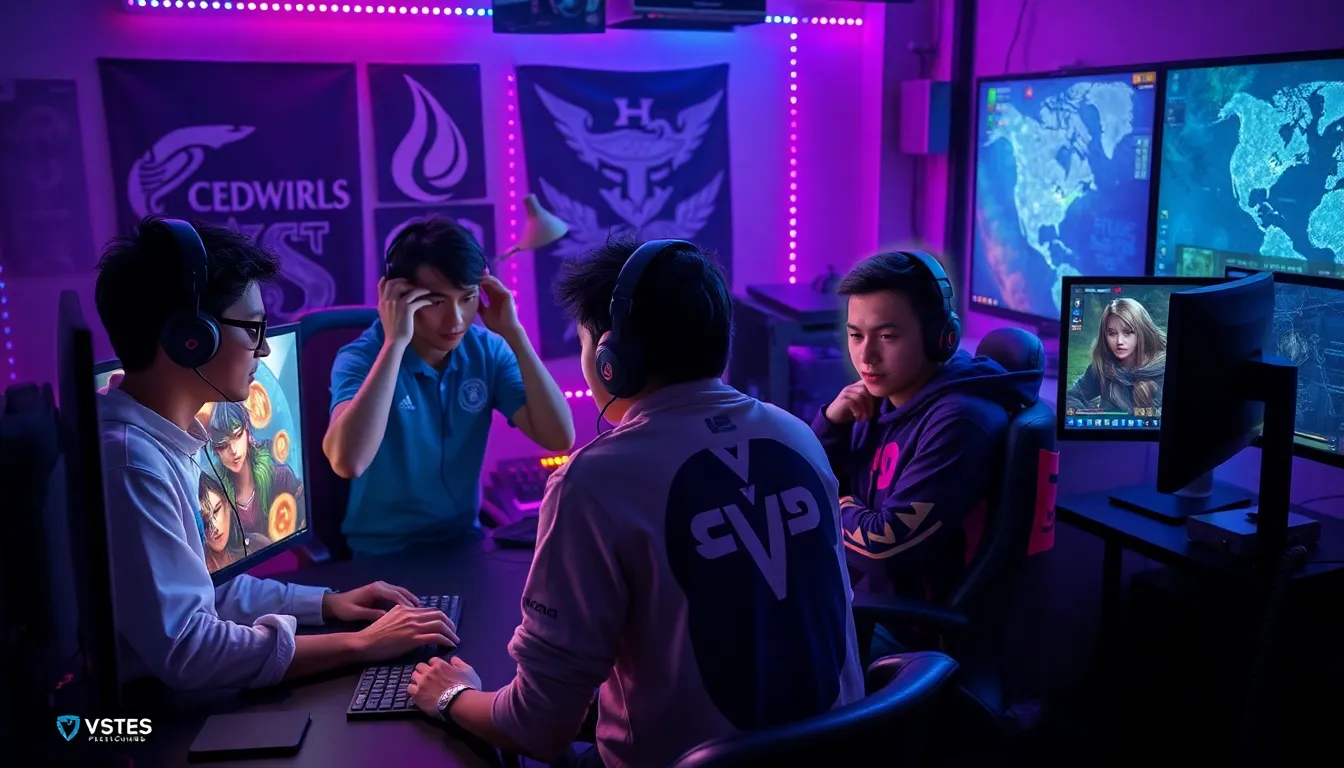Table of Contents
ToggleIn the dynamic world of League of Legends, role selection plays a crucial part in shaping the game experience. Each player’s choice not only impacts their own gameplay but also influences the overall team strategy. Understanding how to effectively select a role can enhance individual performance and foster better teamwork.
With five distinct roles to choose from—Top, Jungle, Mid, ADC, and Support—players face the challenge of finding their niche while considering team composition. Knowing the strengths and weaknesses of each role allows players to make informed decisions that align with their skills and preferences. As the meta evolves, so do strategies for role selection, making it essential for players to stay updated and adaptable.
Overview of League Role Selection
League role selection significantly influences individual performance and team dynamics. Understanding the five primary roles—Top, Jungle, Mid, ADC, and Support—empowers players to make strategic choices that align with their playstyle.
Top Lane
Top lane champions often excel in durability and crowd control. They frequently engage enemies and absorb damage for teammates. Champions like Jax and Malphite demonstrate strong late-game scaling, making them formidable choices.
Jungle
Jungle players have the unique ability to impact all lanes. They secure resources and control objectives like Dragon and Baron. Champions such as Lee Sin and Elise showcase high mobility and utility, allowing for effective ganks and map pressure.
Mid Lane
Mid lane serves as the core for burst damage and crowd control. Mid-laners like Zed and Orianna influence the game flow by roaming to side lanes and executing decisive skirmishes. Mastery of positioning is crucial for success in this role.
ADC
ADC champions provide consistent damage output through basic attacks. They thrive in team fights, requiring positioning and map awareness. Champions like Kai’Sa and Jhin play pivotal roles in late-game scenarios, emphasizing the importance of scaling and teamwork.
Support
Support champions enhance the team’s survivability and utility. They protect the ADC and provide vision control. Champions like Thresh and Lulu empower allies and disrupt enemies, underlining the strategic importance of this role in facilitating team plays.
Players must evaluate their strengths and weaknesses against the current meta to make effective role selections. Flexibility and adaptability remain vital, as the game landscape continuously shifts. Understanding the nuances of each role allows players to contribute more effectively to their team’s success.
Importance of Role Selection in League

Role selection in League of Legends shapes both individual gameplay and overall team synergy. Understanding each role’s characteristics aids players in maximizing their effectiveness during matches.
Impact on Team Composition
Team composition relies heavily on role selection. Each of the five primary roles—Top, Jungle, Mid, ADC, and Support—contributes unique strengths.
- Top lane: Adds durability and frontline presence. Champions in this role often serve as the team’s tank.
- Jungle: Provides map control and objective security, allowing for strategic ganks across lanes.
- Mid lane: Delivers burst damage and crowd control. Successful mid laners dictate the flow of the game.
- ADC: Focuses on consistent damage output. Positioning and mobility become vital in skirmishes and team fights.
- Support: Enhances team survivability and provides vision control, ensuring objectives are secured safely.
Balanced team compositions typically show a mix of these roles. Understanding and selecting appropriately fosters synergy and maximizes team potential.
Influence on Game Strategy
Role selection directly influences game strategy. Each role requires specific playstyles and in-game priorities.
- Top laners often prioritize lane sustainability and team fight contributions.
- Junglers engage in objective control and creating pressure across lanes.
- Mid laners initiate roams to assist other lanes, aiming to snowball the game.
- ADCs focus on farming efficiently while ensuring proper positioning during engagements.
- Supports rotate for vision control and aid their carries in fights.
Adapting playstyle according to selected roles generates strategic advantages. As the game’s meta evolves, understanding these dynamics becomes essential for effective gameplay and overall team success.
Common Roles in League of Legends
Understanding common roles in League of Legends enhances gameplay and strategy. Each role influences team dynamics and overall performance.
Top Lane
Top lane champions typically possess high durability and crowd control. They often act as the team’s tank, absorbing damage while initiating fights. Champions like Malphite and Trundle excel in soaking damage and providing frontline presence. Top laners prioritize maintaining lane sustainability, which includes managing minion waves and taking objectives like Rift Herald. Effective communication with the team ensures optimal use of their resources during skirmishes.
Jungle
Jungle players have a significant impact on all lanes by securing resources and controlling objectives. They excel in map mobility, using varied champions like Lee Sin and Elise to apply pressure and set up ganks. Objective control, such as securing Dragon and Baron, remains crucial for success. Effective jungle pathing and vision control on the map enable successful rotations and assist teammates in securing kills. Junglers need to adapt their strategy based on enemy movements and lane conditions.
Mid Lane
Mid lane champions focus on burst damage and crowd control. Champions like Zed and Ahri influence the game flow by roaming to assist teammates or secure kills. Mid laners often dictate the game’s pace through wave management and map pressure. They prioritize securing vision to maintain control over key areas, facilitating successful ganks from their jungler. Efficient positioning and timing are critical during team fights, allowing mid laners to maximize their impact.
AD Carry
AD Carry (ADC) champions deliver consistent damage output, crucial for team fights. Champions such as Kai’Sa and Jhin thrive on farming minions to gather gold and items. ADCs require strong positioning during battles, focusing on maximizing damage while maintaining safety. They often rely on supports to provide peel and utility, enabling them to focus on targeting enemies. Maintaining vision control in critical areas helps ADCs avoid ambushes while preparing for team engagements.
Support
Support champions enhance team survivability and utility. They prioritize protecting allies, providing vision control, and crowd control. Champions like Thresh and Lulu excel in assisting ADCs and initiating fights. Supports manage vision with control wards and trinkets, ensuring critical areas remain safe for their team. Building items that benefit the entire team reinforces their role, allowing them to contribute meaningfully without dealing direct damage. Good communication with teammates fosters effective strategies in skirmishes and team fights.
Strategies for Effective Role Selection
Effective role selection requires players to evaluate their skills and the needs of their team. This process balances personal strengths with the strategic requirements of each match.
Assessing Personal Strengths
Players must identify their top skills to choose the most suitable role. Recognizing strengths includes evaluating mechanics, communication, and adaptability. For instance, players strong in mechanics often excel in Mid or ADC roles, while those with better map awareness might thrive as Junglers or Supports. A self-assessment approach includes:
- Skill Evaluation: Analyze personal performance in various roles during past matches.
- Champion Proficiency: Focus on champions that align with individual play styles and strengths.
- Comfort Level: Select roles that align with personal enjoyment and familiarity.
Understanding Team Needs
Understanding team composition plays a crucial role in effective selection. Players should assess the needs of the team and the overall strategy. Key considerations include:
- Role Distribution: Ensure a balanced mix of roles to enhance synergy and effectiveness in fights.
- Adaptability: Be ready to adjust role selections based on team discussions and the enemy’s composition.
- Communication: Engage in team discussions to align on strategies and ensure all essential roles are filled.
By assessing personal strengths and understanding team needs, players can make informed decisions that significantly enhance their performance and the team’s success.
Role selection in League of Legends is a pivotal aspect of gameplay that can determine a team’s success. By understanding the unique characteristics of each role players can align their skills with team needs. This alignment fosters better synergy and enhances overall performance.
As the game continues to evolve players must stay informed about the changing meta and adapt their strategies accordingly. Making thoughtful choices regarding role selection not only boosts individual gameplay but also contributes to a balanced team composition. Ultimately, mastering role selection is essential for any player aiming to climb the ranks and achieve success in the competitive landscape of League of Legends.





